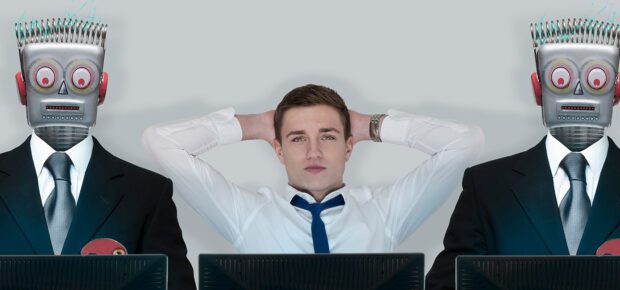February 15, 2022
Over the past few decades, technology has changed the ways we live and work, one innovation at a time. With self-driving cars, intelligent digital agents, robots and other tools advancing rapidly, it’s easy to overlook a simple fact: Computers have taken up a lot of human cognitive work in the 20th century. Now, they’re leveraging self-learning algorithms, pattern recognition and natural language processing to enable faster calculations and data processing.
With faster, more accurate data processing and the ability to automate repetitive tasks, AI and robotics help employees stay focused on creative solutions and complex problem solving, thus increasing efficiency. Minimal human intervention and rising automation have given rise to full-scale robotics in various industries. These technologies are equipped to compete in a fast-changing workspace environment and respond to constant changes that are hard to predict.
Robotics and trends forecast
The World Robotics Report 2021 Industrial Robots report shows a track record of three million industrial robots operating in factories around the world indicating an increase of 10% overall. By 2024, the report forecasts the placement of 518,000 industrial robots. Southeast Asian markets grew by double-digit rates in 2021. The report further explains that a post-crisis boom will create supplementary growth at low double-digit rates in 2022, and in the coming years. It’s safe to say that execution, management, and monitoring in the coming years will increasingly be done by intelligent machines together with human intervention, with superior results.
Rise of the digital workforce
Automated systems can detect inefficiencies that a human mind can skip unknowingly, while AI-driven systems help ensure no errors. As a result, there may be less demand for supervisory roles whose main goal is quality assurance and productivity management. These digitally driven systems also allow workers to have small breaks and more freedom from jobs have become more intense and stressful in current times. This is the most frequent feature of robotics and automation adoption: the augmentation of human effort, rather than the replacement of it. This practice paves the way for the most ideal situation – humans and robots working side by side, empowering and revolutionizing the whole spectrum of work. The fear that robots might come for the jobs, become the boss, stands invalid.
The digital workforce enables effective management of resources – various industries leverage AI-driven solutions to address the unavailability of human resources and drive enhanced customer service. One example we see frequently: a new service model that integrates robotics and automation with e-commerce to provide more personalized services.
In the post-pandemic world, the demand for robots is only going to increase. But that demand will not subside once the effects of the pandemic are absorbed in the broader economy. The digital spaces iterate innovation by facilitating an easy and comprehensive understanding of shortcomings and providing corrective measures. Digital space also reduces risk by effectively addressing any unexpected threats to safety and security, as it did in the COVID-19 pandemic. Statistically, 48% of experts envision a future inclusive of robots and digital agents that would play a significant role for both blue- and white-collar workers.
Challenges in digital workforce transformation
Automated management starts with the workflow and uses certain algorithms to ensure superior results. However, a few challenges limit the effectiveness of the digital workforce and ongoing transformation, such as:
- Lack of expertise to lead digitization initiatives
- Lack of overall digitization strategy
- Unstructured infrastructural changes
- Limited budget on the initial investment
- Issues in human-digital workflow integration
- Difficulty of the human workforce to adapt and internalize the digital processes
Hence, there is a strong need to adapt and repurpose the strategies as per the changing demands of the market and workspace to ensure inter-sector adaptability. Contrary to popular belief, robots are not going to replace human workers, but many jobs may be significantly reimagined to ensure that they fit well within automated workflows. The data from a 2021 report by World Economic Forum reflects that increased automation and the use of AI, ML will lead to more hiring in most sectors while ensuring standardization of processes.
Integrating into Other Industries
With the rise of PC and mobile phone applications, automated call centers and other growing advancements like the Internet of Things (IoT), AI and robotics have already made their way into various business processes across segments, including healthcare, transport and logistics and customer service.
As we move forward into a more digitally-connected world, it will be interesting to see how AI and robotics reshape workplaces globally.
ABOUT OUR AUTHOR
Jayakrishnan T, an IEEE Member, is the founder and C.E.O of ASIMOV Robotics Pvt Ltd, a company that provides engineering products/solutions and consultancy in advanced robotics and AI.






 Meaningful Momentum or Running in Place?
Meaningful Momentum or Running in Place? AI Through Our Ages
AI Through Our Ages Liquid Infrastructure: Our Planet's Most Precious Resource
Liquid Infrastructure: Our Planet's Most Precious Resource The Impact of Technology in 2025
The Impact of Technology in 2025 Quantum and AI: Safeguards or Threats to Cybersecurity?
Quantum and AI: Safeguards or Threats to Cybersecurity? Why AI Can't Live Without Us
Why AI Can't Live Without Us Bits, Bytes, Buildings and Bridges: Digital-Driven Infrastructure
Bits, Bytes, Buildings and Bridges: Digital-Driven Infrastructure Impact of Technology in 2024
Impact of Technology in 2024 Emerging AI Cybersecurity Challenges and Solutions
Emerging AI Cybersecurity Challenges and Solutions The Skies are Unlimited
The Skies are Unlimited Smart Cities 2030: How Tech is Reshaping Urbanscapes
Smart Cities 2030: How Tech is Reshaping Urbanscapes Impact of Technology 2023
Impact of Technology 2023 Cybersecurity for Life-Changing Innovations
Cybersecurity for Life-Changing Innovations Smarter Wearables Healthier Life
Smarter Wearables Healthier Life Infrastructure In Motion
Infrastructure In Motion The Impact of Tech in 2022 and Beyond
The Impact of Tech in 2022 and Beyond Cybersecurity, Technology and Protecting Our World
Cybersecurity, Technology and Protecting Our World How Technology Helps us Understand Our Health and Wellness
How Technology Helps us Understand Our Health and Wellness The Resilience of Humanity
The Resilience of Humanity Harnessing and Sustaining our Natural Resources
Harnessing and Sustaining our Natural Resources Creating Healthy Spaces Through Technology
Creating Healthy Spaces Through Technology Exceptional Infrastructure Challenges, Technology and Humanity
Exceptional Infrastructure Challenges, Technology and Humanity The Global Impact of IEEE's 802 Standards
The Global Impact of IEEE's 802 Standards Scenes of our Cyber Lives: The Security Threats and Technology Solutions Protecting Us
Scenes of our Cyber Lives: The Security Threats and Technology Solutions Protecting Us How Millennial Parents are Embracing Health and Wellness Technologies for Their Generation Alpha Kids
How Millennial Parents are Embracing Health and Wellness Technologies for Their Generation Alpha Kids Space Exploration, Technology and Our Lives
Space Exploration, Technology and Our Lives Global Innovation and the Environment
Global Innovation and the Environment How Technology, Privacy and Security are Changing Each Other (And Us)
How Technology, Privacy and Security are Changing Each Other (And Us) Find us in booth 31506, LVCC South Hall 3 and experience the Technology Moon Walk
Find us in booth 31506, LVCC South Hall 3 and experience the Technology Moon Walk Virtual and Mixed Reality
Virtual and Mixed Reality How Robots are Improving our Health
How Robots are Improving our Health IEEE Experts and the Robots They are Teaching
IEEE Experts and the Robots They are Teaching See how millennial parents around the world see AI impacting the lives of their tech-infused offspring
See how millennial parents around the world see AI impacting the lives of their tech-infused offspring Take the journey from farm to table and learn how IoT will help us reach the rising demand for food production
Take the journey from farm to table and learn how IoT will help us reach the rising demand for food production Watch technical experts discuss the latest cyber threats
Watch technical experts discuss the latest cyber threats Explore how researchers, teachers, explorers, healthcare and medical professionals use immersive technologies
Explore how researchers, teachers, explorers, healthcare and medical professionals use immersive technologies Follow the timeline to see how Generation AI will be impacted by technology
Follow the timeline to see how Generation AI will be impacted by technology Learn how your IoT data can be used by experiencing a day in a connected life
Learn how your IoT data can be used by experiencing a day in a connected life Listen to technical experts discuss the biggest security threats today
Listen to technical experts discuss the biggest security threats today See how tech has influenced and evolved with the Games
See how tech has influenced and evolved with the Games Enter our virtual home to explore the IoT (Internet of Things) technologies
Enter our virtual home to explore the IoT (Internet of Things) technologies Explore an interactive map showcasing exciting innovations in robotics
Explore an interactive map showcasing exciting innovations in robotics Interactively explore A.I. in recent Hollywood movies
Interactively explore A.I. in recent Hollywood movies Get immersed in technologies that will improve patients' lives
Get immersed in technologies that will improve patients' lives